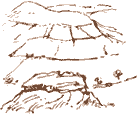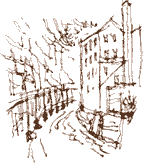|  Because
of the frost, I've been worrying, dreaming even, about climbing Jacob's
Ladder, a partially stepped causeway from Edale to the Kinder
plateau. I've never been here before but I needn't have worried; the curving
incline is dry and frost-free in the mid-morning sun. Some of the surrounding
valleys are swathed in mist but up here it's sunny with clear blue skies.
There isn't much of a breeze, so I soon take off my coat and body warmer
and walk with the sleeves of my sweat shirt rolled back. Because
of the frost, I've been worrying, dreaming even, about climbing Jacob's
Ladder, a partially stepped causeway from Edale to the Kinder
plateau. I've never been here before but I needn't have worried; the curving
incline is dry and frost-free in the mid-morning sun. Some of the surrounding
valleys are swathed in mist but up here it's sunny with clear blue skies.
There isn't much of a breeze, so I soon take off my coat and body warmer
and walk with the sleeves of my sweat shirt rolled back.
 It's
wonderful to walk over the moors of the High Peak and
not hear anything louder than the bubblingly belligerent call of a red
grouse. While I'm working hard to make progress over causeway,
sunken icy paths and peaty mires, the grouse goes the easy way - within
a few minutes it crosses the valley with a gliding but buzzy flight. Later,
right above my head, passengers are also taking the easy route on a British
Airways plane which slows down on the approach to Manchester Airport.
I've seen these moors from the plane on numerous occasions and I'm impressed
by how extensive they are, even when glimpsed from several thousand feet. It's
wonderful to walk over the moors of the High Peak and
not hear anything louder than the bubblingly belligerent call of a red
grouse. While I'm working hard to make progress over causeway,
sunken icy paths and peaty mires, the grouse goes the easy way - within
a few minutes it crosses the valley with a gliding but buzzy flight. Later,
right above my head, passengers are also taking the easy route on a British
Airways plane which slows down on the approach to Manchester Airport.
I've seen these moors from the plane on numerous occasions and I'm impressed
by how extensive they are, even when glimpsed from several thousand feet.
The Ravens of Mount Famine
 At
the halfway point of my walk, at South Head on the western
edge of the High Peak estate, I sit on a tussock of moor grass and eat
my lunch - a honey and banana sandwich (recommended by survival expert
Ray Mears as a energy-boosting lunch when you're spending a day tramping
in the hills). At
the halfway point of my walk, at South Head on the western
edge of the High Peak estate, I sit on a tussock of moor grass and eat
my lunch - a honey and banana sandwich (recommended by survival expert
Ray Mears as a energy-boosting lunch when you're spending a day tramping
in the hills).
 A
couple of crows fly across and, without thinking, I take them as just
that, a couple of crows, until one makes a call and it's not the familiar
'caw!'. They turn out to be ravens, a group
of 6, 8 or more, which keep making sorties from the crags on Mount
Famine, the rough hill overlooking the deep hollow of Dimpus
Clough, immediately to the north of South Head. These sleek glossy
black birds with their deep, honking calls and their powerful but sometimes
acrobatic flight, remind me of Odin's ravens - his messengers who, in
Norse mythology, kept travelling out to the corners of the world and bringing
back the news to their master. A
couple of crows fly across and, without thinking, I take them as just
that, a couple of crows, until one makes a call and it's not the familiar
'caw!'. They turn out to be ravens, a group
of 6, 8 or more, which keep making sorties from the crags on Mount
Famine, the rough hill overlooking the deep hollow of Dimpus
Clough, immediately to the north of South Head. These sleek glossy
black birds with their deep, honking calls and their powerful but sometimes
acrobatic flight, remind me of Odin's ravens - his messengers who, in
Norse mythology, kept travelling out to the corners of the world and bringing
back the news to their master.
Valley and Gorge
 When
you're down on one of the roads - for instance the north-south A624 Hayfield
Road - passing through this hill country, the moors can seem
bulky and rather oppressive. Paradoxically, you can feel hemmed in and
claustrophobic in this big, rugged landscape. When you approach the same
road by coming down from the tops then soon climbing back up again (and,
yes, it is hard work!), the effect is quite different. The valley opens
up before you as a green pastoral contrast to the brown moorland plateau
you've just been walking over. From a small crag on the rim of the valley
I look back towards Mount Famine. I'm getting a real sense of vertigo
as the Hayfield Road lies just 600 metres ahead of me but 180 metres below
me. When
you're down on one of the roads - for instance the north-south A624 Hayfield
Road - passing through this hill country, the moors can seem
bulky and rather oppressive. Paradoxically, you can feel hemmed in and
claustrophobic in this big, rugged landscape. When you approach the same
road by coming down from the tops then soon climbing back up again (and,
yes, it is hard work!), the effect is quite different. The valley opens
up before you as a green pastoral contrast to the brown moorland plateau
you've just been walking over. From a small crag on the rim of the valley
I look back towards Mount Famine. I'm getting a real sense of vertigo
as the Hayfield Road lies just 600 metres ahead of me but 180 metres below
me.
 New
Mills, my journey's end, is another place that is surprising
when you walk around it, rather than driving through it. I always knew
it had a labyrinthine arrangement of gritstone railway viaducts. I now
discover that it has a deep gorge tucked away, out of sight, behind the
bus station. The new Torr Millennium Walkway takes you
right through it, on stilt-like pillars above the River Goyt.
From down here in a chasm with a sheer sandstone cliff to your left and
a lofty, derelict stone-built mill to your right I feel that New Mills
is a mill town designed by the 'mad' visionary Victorian painter for Biblical
cataclysm, John Martin. New
Mills, my journey's end, is another place that is surprising
when you walk around it, rather than driving through it. I always knew
it had a labyrinthine arrangement of gritstone railway viaducts. I now
discover that it has a deep gorge tucked away, out of sight, behind the
bus station. The new Torr Millennium Walkway takes you
right through it, on stilt-like pillars above the River Goyt.
From down here in a chasm with a sheer sandstone cliff to your left and
a lofty, derelict stone-built mill to your right I feel that New Mills
is a mill town designed by the 'mad' visionary Victorian painter for Biblical
cataclysm, John Martin.
As I walk around the town, waiting for my train, mist builds up in the
valley, stirring up a chillingly portentous atmosphere down in the gorge
as the light fades. 
Richard Bell, richard@willowisland.co.uk
|